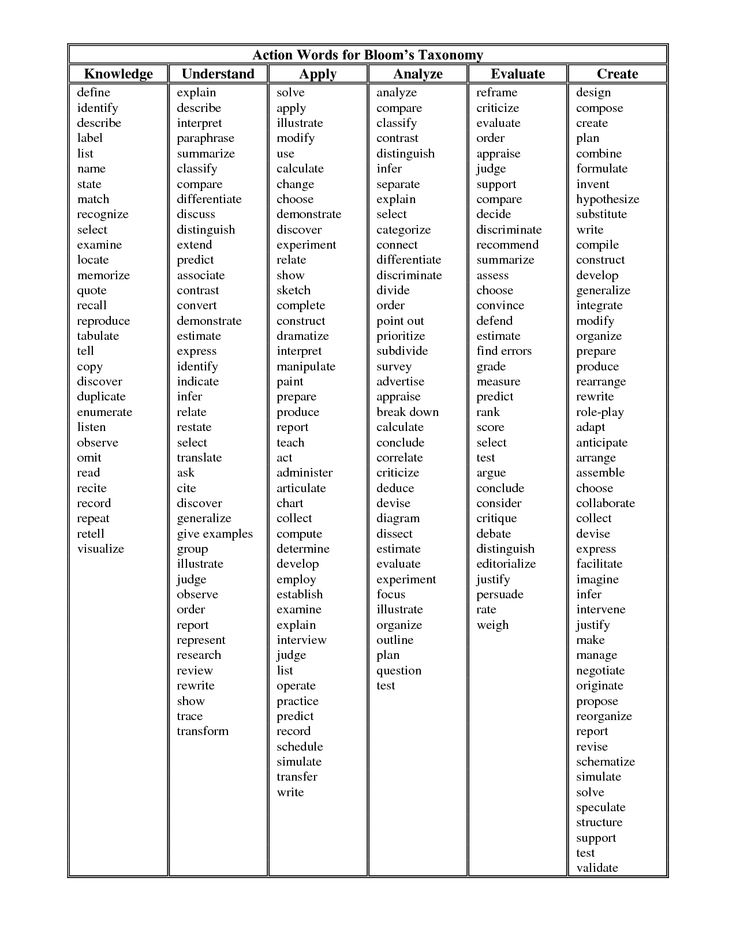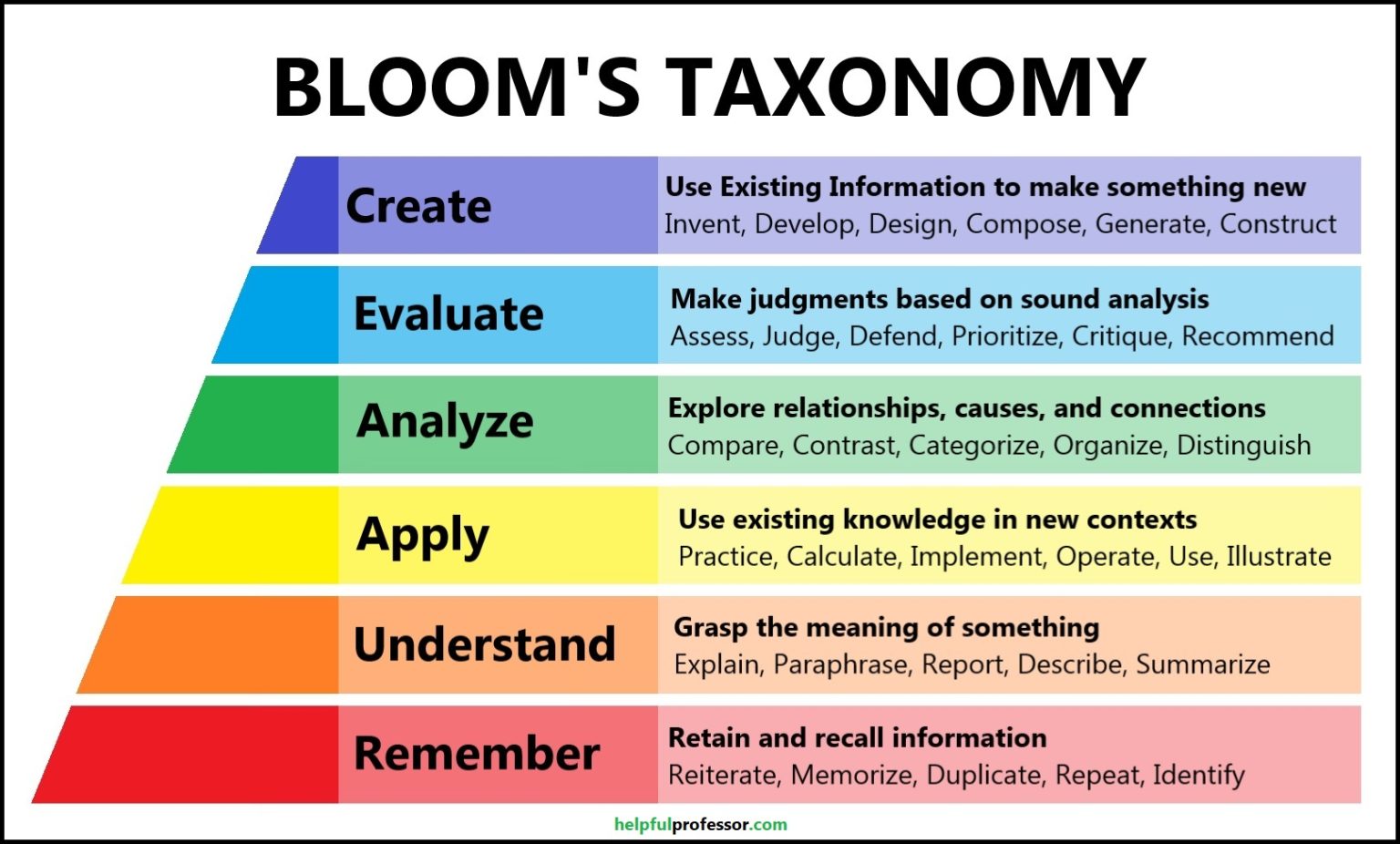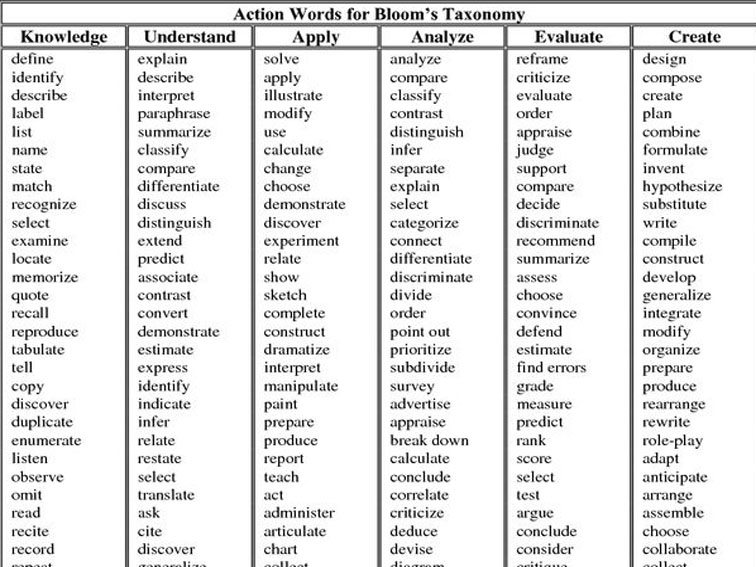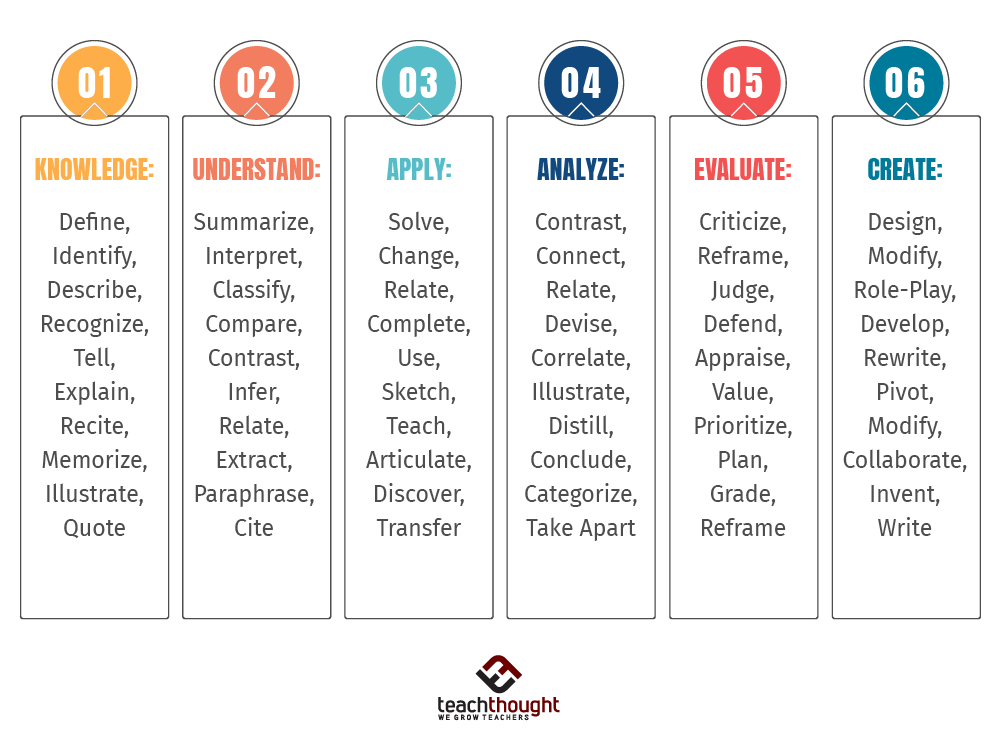Bloom S Taxonomy Verb Chart
Bloom S Taxonomy Verb Chart - Judgments about make inferences and find evidence to. Bloom’s taxonomy can be useful for course design because the different levels can help you move students through the process of. 64 rows bloom’s taxonomy provides a list of action verbs based on each level of understanding. This table of verbs lists cognitive processes that fit into bloom’s six categories and help identify the cognitive complexity or the order of thinking. Examine and break present and information into parts by identifying motives or causes. Examine and break information into parts by identifying motives or causes. Make inferences and find evidence to support generalizations. The chart below arranges bloom's levels of cognitive activity from simple to complex and lists verbs that correspond to each level.
Bloom’s taxonomy can be useful for course design because the different levels can help you move students through the process of. Examine and break information into parts by identifying motives or causes. Make inferences and find evidence to support generalizations. This table of verbs lists cognitive processes that fit into bloom’s six categories and help identify the cognitive complexity or the order of thinking. 64 rows bloom’s taxonomy provides a list of action verbs based on each level of understanding. Examine and break present and information into parts by identifying motives or causes. The chart below arranges bloom's levels of cognitive activity from simple to complex and lists verbs that correspond to each level. Judgments about make inferences and find evidence to.
64 rows bloom’s taxonomy provides a list of action verbs based on each level of understanding. Judgments about make inferences and find evidence to. This table of verbs lists cognitive processes that fit into bloom’s six categories and help identify the cognitive complexity or the order of thinking. Bloom’s taxonomy can be useful for course design because the different levels can help you move students through the process of. Examine and break information into parts by identifying motives or causes. Make inferences and find evidence to support generalizations. The chart below arranges bloom's levels of cognitive activity from simple to complex and lists verbs that correspond to each level. Examine and break present and information into parts by identifying motives or causes.
249 Bloom's Taxonomy Verbs For Critical Thinking
64 rows bloom’s taxonomy provides a list of action verbs based on each level of understanding. Judgments about make inferences and find evidence to. The chart below arranges bloom's levels of cognitive activity from simple to complex and lists verbs that correspond to each level. Examine and break present and information into parts by identifying motives or causes. This table.
119 Bloom’s Taxonomy Examples (2024)
Examine and break present and information into parts by identifying motives or causes. Make inferences and find evidence to support generalizations. Bloom’s taxonomy can be useful for course design because the different levels can help you move students through the process of. The chart below arranges bloom's levels of cognitive activity from simple to complex and lists verbs that correspond.
[IB] 영어 원서수업 8차시 두 번째 원서 '21세기를 위한 21가지 제언' 인트로! 네이버 블로그
Make inferences and find evidence to support generalizations. The chart below arranges bloom's levels of cognitive activity from simple to complex and lists verbs that correspond to each level. Judgments about make inferences and find evidence to. Examine and break present and information into parts by identifying motives or causes. 64 rows bloom’s taxonomy provides a list of action verbs.
Bloom's Taxonomy Verbs Free Classroom Chart
The chart below arranges bloom's levels of cognitive activity from simple to complex and lists verbs that correspond to each level. Judgments about make inferences and find evidence to. 64 rows bloom’s taxonomy provides a list of action verbs based on each level of understanding. Bloom’s taxonomy can be useful for course design because the different levels can help you.
Bloom's Taxonomy Bloom's Taxonomy Education
Bloom’s taxonomy can be useful for course design because the different levels can help you move students through the process of. Examine and break information into parts by identifying motives or causes. Judgments about make inferences and find evidence to. The chart below arranges bloom's levels of cognitive activity from simple to complex and lists verbs that correspond to each.
Pin on Teaching
Examine and break information into parts by identifying motives or causes. Bloom’s taxonomy can be useful for course design because the different levels can help you move students through the process of. This table of verbs lists cognitive processes that fit into bloom’s six categories and help identify the cognitive complexity or the order of thinking. Judgments about make inferences.
Bloom's Taxonomy 2024 Verbs, Chart, & How to Use This All
Examine and break present and information into parts by identifying motives or causes. Make inferences and find evidence to support generalizations. The chart below arranges bloom's levels of cognitive activity from simple to complex and lists verbs that correspond to each level. 64 rows bloom’s taxonomy provides a list of action verbs based on each level of understanding. Judgments about.
249 Bloom's Taxonomy Verbs For Critical Thinking
Make inferences and find evidence to support generalizations. Bloom’s taxonomy can be useful for course design because the different levels can help you move students through the process of. This table of verbs lists cognitive processes that fit into bloom’s six categories and help identify the cognitive complexity or the order of thinking. The chart below arranges bloom's levels of.
100+ Bloom's Taxonomy Verbs For Critical Thinking
The chart below arranges bloom's levels of cognitive activity from simple to complex and lists verbs that correspond to each level. Bloom’s taxonomy can be useful for course design because the different levels can help you move students through the process of. Judgments about make inferences and find evidence to. Make inferences and find evidence to support generalizations. 64 rows.
Bloom's Taxonomy Verbs Poster for Teachers
Make inferences and find evidence to support generalizations. 64 rows bloom’s taxonomy provides a list of action verbs based on each level of understanding. This table of verbs lists cognitive processes that fit into bloom’s six categories and help identify the cognitive complexity or the order of thinking. Examine and break information into parts by identifying motives or causes. The.
This Table Of Verbs Lists Cognitive Processes That Fit Into Bloom’s Six Categories And Help Identify The Cognitive Complexity Or The Order Of Thinking.
64 rows bloom’s taxonomy provides a list of action verbs based on each level of understanding. Judgments about make inferences and find evidence to. Bloom’s taxonomy can be useful for course design because the different levels can help you move students through the process of. The chart below arranges bloom's levels of cognitive activity from simple to complex and lists verbs that correspond to each level.
Examine And Break Information Into Parts By Identifying Motives Or Causes.
Make inferences and find evidence to support generalizations. Examine and break present and information into parts by identifying motives or causes.


![[IB] 영어 원서수업 8차시 두 번째 원서 '21세기를 위한 21가지 제언' 인트로! 네이버 블로그](https://www.valamis.com/wp-content/uploads/2022/09/blooms-taxonomy-verbs.png)






